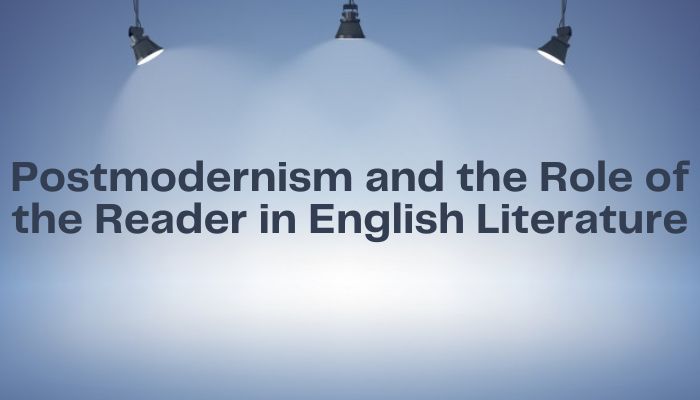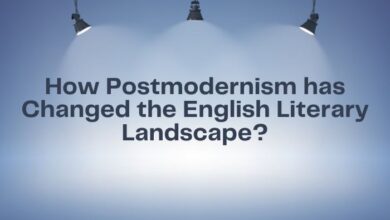Postmodernism and the Role of the Reader in English Literature

As a literary movement, Postmodernism has challenged the traditional notion of authorship and the reader’s role in interpreting a text. The postmodern literary theory emphasizes the importance of the reader in constructing meaning rather than considering the author as the sole source of meaning. This article explores the concept of Postmodernism and its impact on the reader’s role in English literature.
The Emergence of Postmodernism
Postmodernism is a complex cultural phenomenon that emerged in the latter half of the 20th century as a response to modernism. The roots of Postmodernism can be traced back to the early 20th century when modernism first emerged as a literary and artistic movement. A rejection of traditional forms and an embrace of experimentation and innovation characterized modernism.
However, modernism became increasingly concerned with self-expression and individualism as it developed. This led to a fragmentation of the artistic community and a rejection of shared values and traditions. Postmodernism emerged as a response to this fragmentation, seeking to restore a sense of community and shared cultural values.
Several social and cultural changes also influenced the emergence of Postmodernism. The rise of mass media and consumer culture led to cultural homogenization, where all cultural forms were considered equally valid. This led to rejecting the traditional hierarchy of cultural forms, with popular culture being seen as just as good as high culture.
Postmodernism also emerged in response to the political and social changes of the 1960s and 1970s. The civil rights movement, the women’s movement, and the counterculture of the 1960s all challenged traditional values and institutions, leading to cultural upheaval and transformation.
In literature, Postmodernism is characterized by rejecting traditional narrative forms and embracing experimentation and fragmentation. Postmodern writers often use intertextuality, pastiche, and parody techniques to challenge conventional notions of authorship and explore the relationship between the text and the reader.
The Role of the Reader in Postmodern Literature
In postmodern literature, the reader’s role is as important as the author’s intent. Postmodernism challenges traditional notions of authorship and encourages readers to actively engage with the text and construct their meaning.
One of the critical features of postmodern literature is intertextuality, which refers to how other texts shape a text. Postmodern writers often incorporate references to other works of literature, art, and popular culture, creating a web of interconnected meanings that requires the reader to engage with the text and its intertextual references actively.
Another key feature of postmodern literature is fragmentation, which refers to how the text is broken into smaller, separate pieces. This fragmentation can make it difficult for the reader to discern a single, unified meaning from the text, requiring the reader to actively construct their meaning from the fragmented pieces.
Pastiche is another key feature of postmodern literature, which refers to how postmodern writers borrow and remix elements from different genres and styles of writing. This requires the reader to be familiar with a wide range of cultural forms and actively engage with the text to identify the various elements and their meanings.
Reader Response Theory
Reader Response Theory is a literary criticism approach that emphasizes the reader’s role in interpreting a literary text. This theory challenges the traditional notion that the meaning of a text is determined solely by the author’s intent and argues that readers actively construct their meanings from the text.
The central idea of Reader Response Theory is that the reader actively participates in constructing meaning from a text. According to this theory, a text is not a fixed, unchanging entity but a dynamic and fluid process of interpretation that is influenced by the reader’s individual experiences, attitudes, and values.
Reader Response Theory recognizes that different readers bring different experiences and backgrounds to reading a text, which can lead to varying interpretations of the same text. This theory also emphasizes the importance of the reader’s emotional response to the text, arguing that emotional reactions can play a significant role in the construction of meaning.
Reader Response Theory has been influential in postmodern literary criticism, as it emphasizes the importance of the reader’s role in constructing meaning and challenges the traditional notion of authorial authority. This theory has also been used to explore issues of identity, power, and social justice, as it recognizes the diversity of readers and how different readers may interpret a text based on their experiences and backgrounds.
Postmodernism and Reader Response Theory
Postmodernism and Reader Response Theory fundamentally challenge traditional notions of authorship and the construction of meaning in literary texts. Both reject the idea that meaning is fixed and determined solely by the author’s intent, and both emphasize the reader’s active role in interpreting a text.
Postmodern literature often employs intertextuality, fragmentation, and pastiche, which require readers to engage with the text and construct its meaning actively. Reader Response Theory recognizes this active role of the reader and emphasizes the importance of the reader’s individual experiences and attitudes in building meaning.
In postmodern literature, the reader’s role is significant because of the fragmented and intertextual nature of the text. Without the reader’s active participation, it can be not easy to discern a single, unified meaning from the text. Reader Response Theory recognizes this importance and emphasizes the reader’s role in shaping a text’s meaning.
Postmodernism and Reader Response Theory also share a concern with issues of power and identity. Postmodernism often critiques dominant power structures and questions traditional notions of identity and subjectivity. At the same time, Reader Response Theory recognizes the diversity of readers and how individual experiences and backgrounds can shape the interpretation of a text.
Examples of Postmodern Literature
Postmodern literature is characterized by its self-reflexivity, intertextuality, and fragmentation, among other features. Some of the most well-known examples of postmodern literature include:
- “Infinite Jest” by David Foster Wallace: This novel is a sprawling, complex work that employs multiple narrative threads and intertextual references. It also features many voices and perspectives, including footnotes that are often as important as the main text.
- “House of Leaves” by Mark Z. Danielewski: This novel is known for its unconventional formatting and use of typography to create a sense of disorientation and confusion. It also features multiple narratives and layers of meaning that require active engagement from the reader.
- “White Noise” by Don DeLillo: This novel explores the themes of consumerism, media saturation, and the fear of death in a fragmented and non-linear narrative style. It also incorporates elements of satire and irony to critique contemporary society.
- “Beloved” by Toni Morrison: This novel uses a non-linear narrative structure and fragmented storytelling to explore the trauma of slavery and its impact on individual and collective memory. It also incorporates elements of magical realism to blur the boundaries between past and present.
- “If on a winter’s night a traveler” by Italo Calvino: This novel is a playful and experimental work that challenges the reader’s expectations of traditional narrative structure. It features multiple beginnings and endings, metafictional elements, and a self-reflexive narrative voice.
FAQs
- What is Postmodernism?
Postmodernism is a literary movement that challenges traditional notions of authorship and the reader’s role in interpreting a text.
- How does Postmodernism challenge traditional notions of authorship?
Postmodernism challenges traditional notions of authorship by emphasizing the importance of the reader in constructing meaning rather than considering the author as the sole source of meaning.
- What is reader response theory?
Reader response theory is a literary theory that emphasizes the reader’s role in constructing meaning. It suggests that the reader’s text interpretation is as important as the author’s intent.
- What are some key features of Postmodern literature?
Some key features of Postmodern literature include intertextuality, fragmentation, and pastiche. These features challenge traditional notions of authorship and encourage readers to engage actively with the text.
- What is the importance of the reader in Postmodern literature?
The importance of the reader in Postmodern literature lies in the fact that the reader’s interpretation is just as important as the author’s intent. Postmodernism encourages readers to engage with the text and construct their meaning actively.

